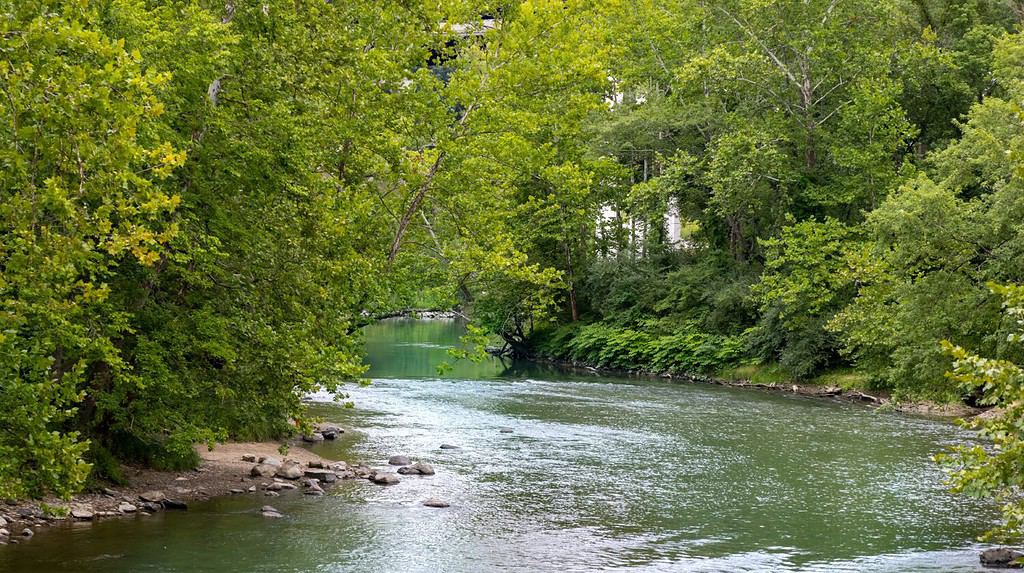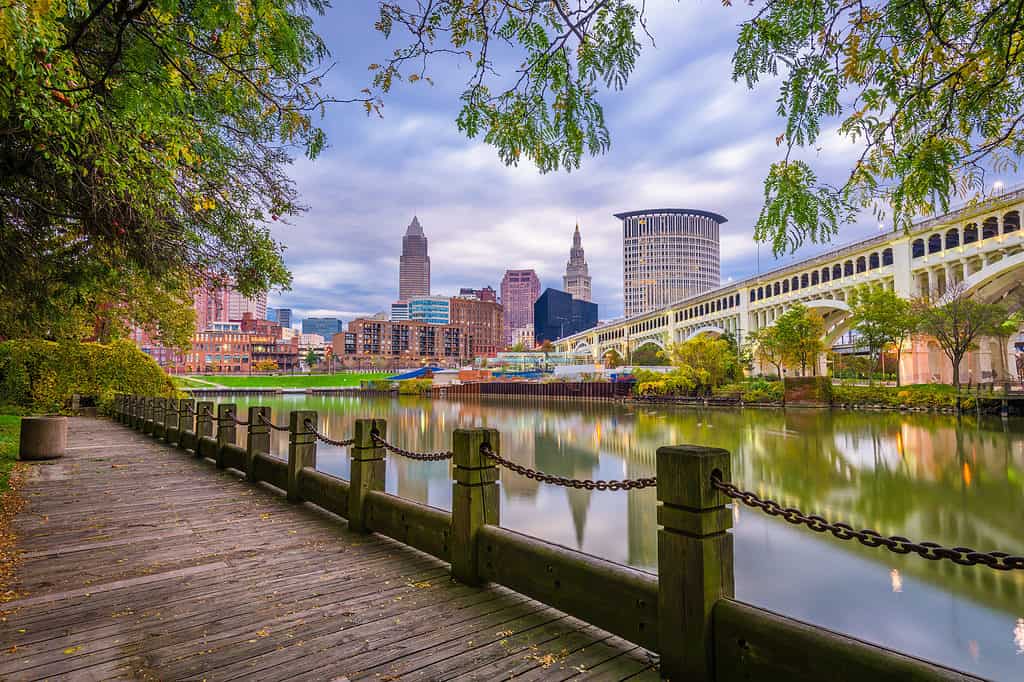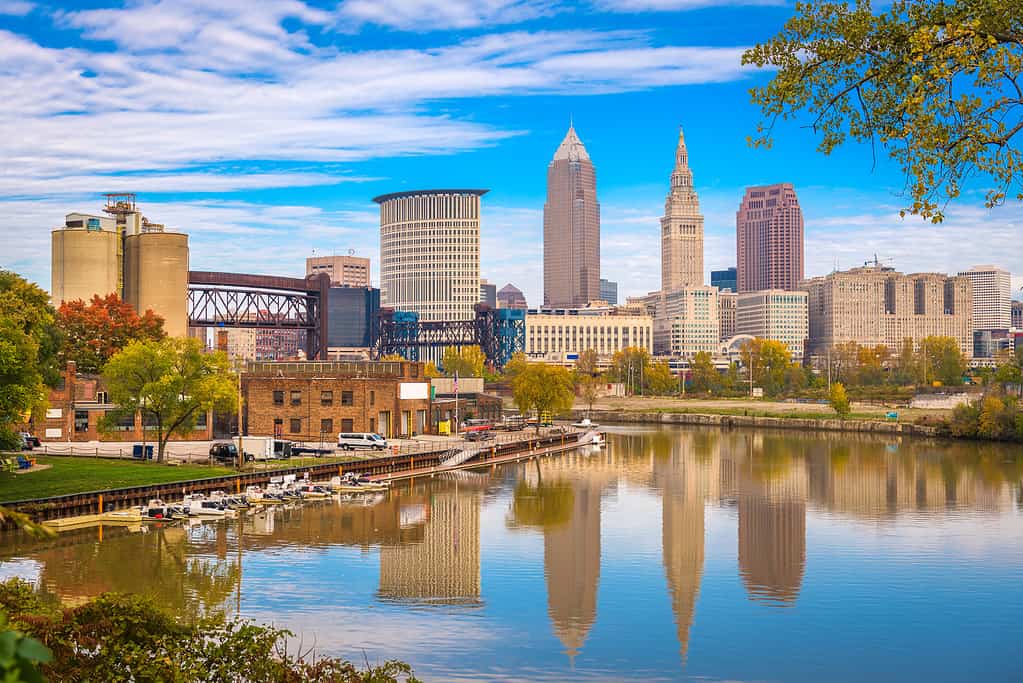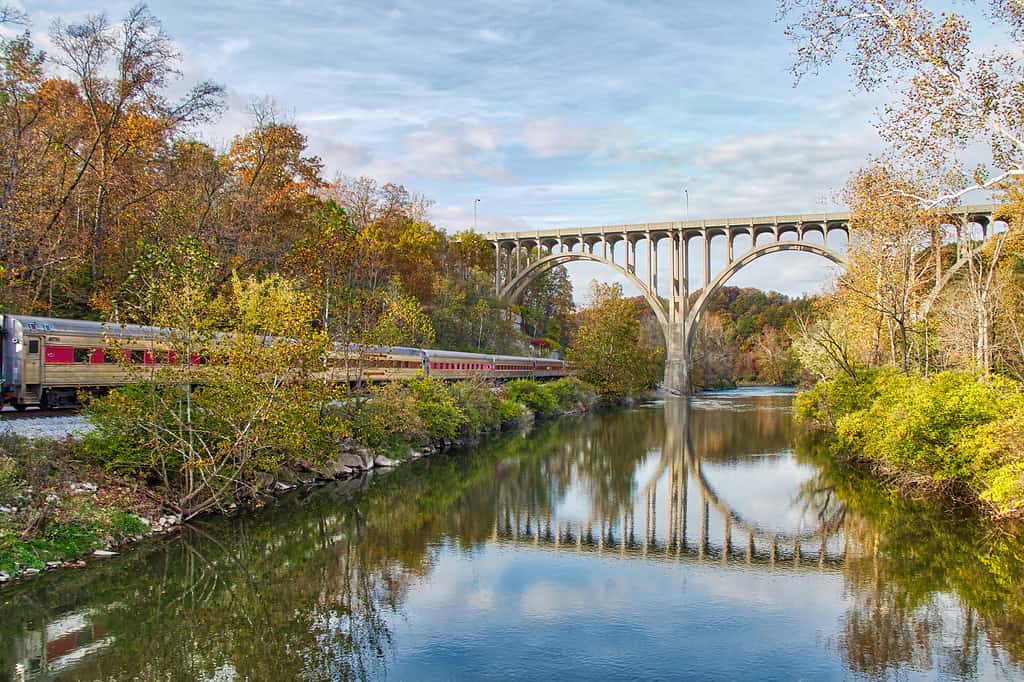The Cuyahoga River is a small but iconic river winding through Northeastern Ohio. This river winds from its headwaters in Geauga County to Cleveland and Lake Erie, with a U-shape form winding its way through rural and urban areas in Ohio.
The name “Cuyahoga” comes from the Mohawk Native American term “Cayagaga,” which means “crooked river.” It’s a perfect way to describe this narrow and small waterway. But the river, after decades of environmental disregard, is also one of America’s symbols of ecological awareness and resilience.
Keep reading to learn more about the Cuyahoga River’s length and other characteristics.
Where Does the Cuyahoga River Start?

In Akron, the river stops its journey southward and continues northward towards Cleveland.
©Sean Pavone/iStock via Getty Images
The Cuyahoga River originates in the northeastern part of Ohio, specifically in the highlands of Geauga County, between the townships of Hambden and Montville. This area is part of the Appalachian Plateau, a geographic area characterized by hills, forests, and abundant water sources.
The river then flows southward through various towns and cities before switching northward near Akron, OH. On its journey toward Lake Erie, it gathers water from numerous tributaries and small streams.
How Long Is the Cuyahoga River?

The river is only 85 miles long and is concentrated in northeastern Ohio.
©SNEHIT PHOTO/Shutterstock.com
The Cuyahoga River is roughly 85 miles long (136 kilometers); compared to some rivers in the United States, it is a relatively short body of water. Its short length is in part due to the local and regional geography. The river primarily flows through northeastern Ohio and meanders through hilly terrain, forests, and urban areas. It winds through dozens of communities, including cities like Akron and Cuyahoga Falls.
Once along its course, the Cuyahoga River had multiple dams controlling its water inflow and level. The Kent Dam, originally built for industrial purposes, is the oldest masonary dam in Ohio. Downstream, the Gorge Dam is set for removal in 2026.
After a journey of 85 miles (136 kilometers), the Cuyahoga River arrives in Cleveland, OH, and in the famous Lake Erie.
How Does the Cuyahoga River Length Compare to Other Rivers?
Even with a length of approximately 85 miles (136 kilometers), the Cuyahoga River is small, especially when compared to the longest rivers in the United States. It is not even part of the ten longest rivers in Ohio.
| Name | Length (Miles) |
|---|---|
| Missouri River | 2,341 |
| Mississippi River | 2,340 |
| Rio Grande | 1,896 |
| Colorado River | 1,450 |
| Ohio River | 981 |
| Tennessee River | 652 |
| Wabash River | 503 |
| Potomac River | 405 |
| Hudson River | 315 |
| Cuyahoga River | 85 |
Where Does the Cuyahoga River End?

Cleveland, OH, is where the river stops its journey after 85 miles (136 kilometers).
©iStock.com/Sean Pavone
The river starts from its headwaters in Geauga County before flowing through northeastern Ohio and arriving in Cleveland. There, it empties into Lake Erie near Cleveland’s downtown area, at Lakefront State Park. Lake Erie is the fourth-largest and easternmost of the Great Lakes. The connection between the Cuyahoga River’s waters and Lake Erie’s water is critical to the regional ecosystem and significantly impacts water quality and the environment. The Cuyahoga River is one of the main tributaries feeding into Lake Erie.
What Are the River’s Tributaries?

The Cuyahoga River is fed by large rivers and small streams.
©LarryKnupp/iStock via Getty Images
At first, the river is known as the East and West Branch of the Cuyahoga River in Geauga County, OH. As it flows from its headwaters, it gains volume and transforms into a large river thanks to its many tributaries, forming the Cuyahoga River.
- Tinkers Creek is the largest tributary of the Cuyahoga River from the southeast. With its headwaters in Summit County, this tributary runs through the Cuyahoga Valley National Park. This park is famous for its natural beauty and recreational opportunities.
- Yellow Creek is a minor tributary that joins the Cuyahoga River from the south. It originates in Portage County and flows through Akron before entering the Cuyahoga River.
- Brandywine Creek is a tributary flowing through Cuyahoga Valley National Park before meeting the Cuyahoga. This creek is known for its scenic beauty and recreational opportunities.
The river’s tributaries, streams, and creeks contribute to the river’s water quality, flow, and ecological diversity. They are essential components of the river’s watershed and vital for northeastern Ohio’s broader ecosystem.
How Wide Is the Cuyahoga River?

The river is at its widest in Cleveland, OH.
©Sean Pavone/iStock via Getty Images
The Cuyahoga River’s width varies significantly along its course as it winds through rural and urban areas. Many geographical features, such as the location, flow rate, and human-made structures, can influence its width.
In its upper reaches and more rural and natural areas, the Cuyahoga River is relatively narrow, often spanning between 50 to 100 feet (15 to 30 meters) in width. The Cuyahoga Valley National Park is home to the narrowest portions of the river.
When the Cuyahoga River approaches cities like Akron and its endpoint, Cleveland, its width increases. In some sections, the river can attain over a hundred feet wide.
How Deep Is the Cuyahoga River?

The mouth of the river, just before joining Lake Erie, is where the Cuyahoga River is the deepest.
©Kenneth Sponsler/iStock via Getty Images
Like its width, the Cuyahoga River’s depth is significantly influenced along its course through northeastern Ohio. Its deepest point is at 70.88 feet (21.6 meters), right before the river empties in Lake Erie in Cleveland. The river’s depth is relatively shallow in its upper reaches, specifically in its headwaters in Geauga County. On average, the Cuyahoga River is only three to six feet deep (0.9 to 1.8 meters).
Many factors influence the depth of the Cuyahoga River. First, the four seasons and their distinct weather patterns affect the river’s depth. During periods of rainfall and snow, water levels are higher and lower during the summer and drier months. Additionally, the dams on the river’s course significantly impact the river’s depth when they release an inflow of water.
What Wildlife Live in and around the Cuyahoga River?

The
kingfisher
is a common species found around the Cuyahoga River in Ohio.
©CreativeNature_nl/iStock via Getty Images
The Cuyahoga River and its surrounding environments provide diverse habitats supporting an extensive range of wildlife. The region is home to both aquatic and terrestrial species.
- Amphibians and Reptiles: Bullfrogs, green frogs, painted turtles, and northern water snakes inhabitant the riverbanks and the nearby wetlands.
- Birds: Bald eagles, great blue herons, kingfishers, and warblers live in the area.
- Fish: The river is home to various fish species, including channel catfish, largemouth bass, northern pike, smallmouth bass, and numerous species of minnows and darters. These are prized catches for anglers in the region.
- Mammals: The Cuyahoga River and its surroundings are home to mainly small mammals such as beavers, eastern gray squirrels, and raccoons. White-tailed deer can often be seen in the neighboring forests.
- Mussels: Many freshwater mussels live in the river, such as the eastern elliptio and northern riffleshell. They both play a vital role in maintaining water quality by filtering impurities from the water.
The Cuyahoga River was once famous for being highly polluted and has caught on fire several times. The river’s water quality primarily increased thanks to conservation efforts and better management practices. The region saw a resurgence in wildlife populations, specifically for fish populations. Today, ongoing efforts focus on improving and restoring endangered habitats.
What Activities Are There to Do on and Along the Cuyahoga River?

The Cuyahoga Valley Scenic Railroad offers a unique way to visit the area with a two-hour ride.
©Laser1987/iStock via Getty Images
With its 85 miles (136 kilometers) length, the Cuyahoga River offers a wide range of outdoor and recreational activities for locals and visitors to enjoy. There is something to enjoy for everyone!
- Hiking and Biking: The Cuyahoga Valley National Park, with a significant portion of the Cuyahoga River valley, provides numerous trails for hiking and biking. The Ohio & Erie Canal Towpath Trail is famous, with scenic river views, woodlands, and historic structures.
- Kayaking and Canoeing: The river is obviously a great place for kayaking and canoeing, a great option to observe the natural beauty and the wildlife up close.
- Fishing: The river teems with fish and has several access points, making it convenient for anglers.
- Scenic Train Ride: Hop on this historic train that will take you via the Cuyahoga Valley Scenic Railroad. Pro tip? Go in the fall and admire the trees and their vibrant foliage colors.
- Waterfalls: The Cuyahoga Valley National Park is the perfect spot to enjoy the quiet atmosphere of waterfalls. Head out to Brandywine Falls for a peaceful experience.
- Wildlife Watching: The Cuyahoga River is home to many wildlife species and is the perfect spot for wildlife watching.
- Camping: One day is not enough to enjoy the premises of the river? Enjoy various campsites along the lake!
- Historical Exploration: Visitors can explore the region and the river’s history at various sites, such as the Canal Exploration Center and the Hale Farm and Village. The area is also home to charming and historic villages.
Why Is the Cuyahoga River Famous?

The Cuyahoga River was covered in oil slicks during heavy and non-regulated industrialization.
©M/iStock via Getty Images
The Cuyahoga River played a significant role in its neighboring communities as a vital waterway for transportation, industry, and commerce. However, its extensive industrialization led to severe pollution, one infamous reason for its notoriety. During the late 19th and early 20th centuries, the region’s industrialization led to a significant dumping of chemicals, oil, and industrial waste in the river.
Because of its high pollution level, the river caught fire multiple times. The fires symbolized the extreme pollution and environmental disregard towards the river. Everyone knew the river was polluted at the time, but no one cared. If it was polluted, the economy was booming, and everyone had jobs.
However, the most famous fire in the river in 1969 drew national attention. On the morning of June 22, 1969, an oil slick on the river caught fire. The blaze lasted 30 minutes and only caused $50,000 in damages to railroad bridges. At first, nothing seemed to be different from other fires. However, a year later, Congress established the Environmental Protection Agency in January 1970. They also created a federal bureau to oversee pollution regulations. This fire also led to the passage of the Clean Water Act in 1972.
To this day, the Cuyahoga River remains a symbol of environmental awareness. It led to the creation of crucial environmental protection laws and marked a shift towards regulating industrial pollution in the United States.
The photo featured at the top of this post is © iStock.com/PapaBear
Thank you for reading! Have some feedback for us? Contact the AZ Animals editorial team.







